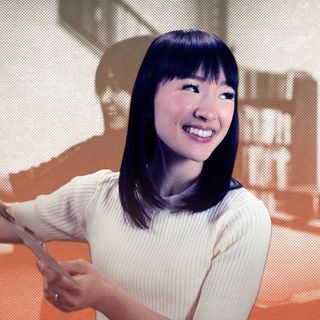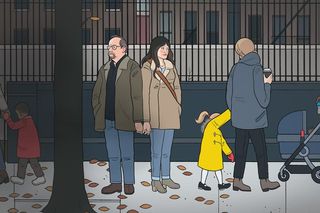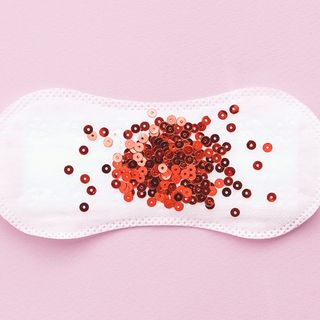
‘Private Life’ Exposes Uncomfortable Truths About Our Compulsive Pursuit of Parenthood
In a film about the quest to find fertility, one couple loses themselves.

Private Life is one of those movies that lingers in your Netflix queue. It premiered a year ago, at 2018’s Sundance Film Festival, but released on Netflix (and therefore, to the world) only late last year. A small, indie film starring powerhouses Paul Giamatti and Katherine Hahn, it’s one you know is going to be good — but never find yourself quite in the mood to watch. Not unfunny, but not funny enough to be a comedy; not undramatic, but with too few extreme highs and lows to be a drama, it’s a movie about, well, life. You put it in your queue, and assume one day you’ll watch it.
Written and directed by Tamara Jenkins, Private Life is the story of Richard and Rachel Grimes (Giamatti and Hahn), a couple trying, with increasing desperation, to become parents. In their late 40s, and described by Richard’s sister-in-law Cynthia (Molly Shannon) as “fertility junkies,” they are recognizable as that urban, educated, successful, upper-middle-class, ‘you can have it all’ couple for whom intellectual heft and achievement obscured biological realities. Until those very realities catch up to them in failed fertility treatments and failed adoption efforts.
The first third of the movie evokes a strong sense of failure as it sets up a somewhat slow-moving plot: after much effort, the couple has an egg from Rachel, but no sperm; then, after borrowing thousands of dollars from Richard’s brother to afford the necessary treatment, they have Richard’s sperm, but Rachel’s ‘elderly’ egg doesn’t fertilize into a viable embryo and fails to implant in her ‘elderly’ womb. Have you considered an egg donor? the doctor suggests.
Related on The Swaddle:
IVF Can Bring Anger, Guilt, Defeat Before the ‘Good News’
Enter Sadie, Richard’s 25-year-old step-niece, who comes to live with the artsy, “cool” aunt and uncle she aspires to be like after dropping out of university, where her creative spirit kept her from finding meaning. On-screen, it’s less tenuous than it sounds, in large part thanks to Kayli Carter, who plays Sadie with a good-hearted but graceless callowness that makes the character seem younger than her years. And indeed, “That’s the point, isn’t it?” as Richard says when he and Rachel discuss whether or not to ask Sadie to be their egg donor. Sadie’s simultaneous immaturity and maturity is the point of the film, which is relentless in its conveyance of the passage of time, of aging, and of the blithe ignorance of youth to both. Rachel, Richard and the camera all dwell on the bodies of Sadie and other young women with a hunger that is at once desexualized and still uncomfortable. There is a strong sense of ‘you don’t know what you have, until it’s gone.’
While overtly, that thing is youth, and fertility, the film’s subtext suggests it’s also humanity. In the film’s opening salvo, Richard and Rachel sit amid a small sea of other couples, all clad in identical hairnets and hospital gowns, waiting to undergo their fertility treatments. The dehumanizing experience of industrialized reproduction hits the viewer over the head — carelessly blunt, yet relentlessly upbeat doctors are framed through Rachel’s splayed knees. For good measure, peppered throughout the film are references to animals. In one quiet scene, Rachel takes pill after pill of supplements and hormones aimed at prompting max fertility, and ends by feeding the couple’s dogs medication from a bottle sitting on the same shelf as her own.
Among a generation with more education, more disposable income, a generation of delayed ‘adulting’ and delayed parenthood, eggs and sperm have become the most precious natural resource. And in our socially compulsive quest to mine our bodies for them — “It’s not your fault … you’ve just been co-opted by societal mechanisms that create desirability,” Sadie says to Richard and Rachel at one point — we inadvertently mine our human spirit also, excising it bit by bit. The moment when Richard and Rachel ask Sadie to be their egg donor feels not-quite-but-almost exploitative, made more uncomfortable by the couple’s awareness of the thinness of the line. Later, in a pivotal scene, human civility is juxtaposed with animalistic essentiality when Richard rages at a fertility doctor for treating his step-niece-cum-egg-donor like a farm animal. In his anger, he purposefully knocks over a display of pamphlets, which scatter across the waiting room. Immediately, he shrinks from the ungoverned emotion. “Sorry,” he says softly, to the waiting room filled with similar couples, as he bends to pick up the pamphlets. “Sorry,” he says to the doctor he just berated.
Related on The Swaddle:
‘Bird Box’ Shows Us a Version of Motherhood We Rarely Get To See
With a running time of just over two hours, the film feels a bit longer thanks to a handful of scenes that probably could’ve been axed for the sake of conciseness. But that is a nitpick. For the most part, Jenkins’ storytelling is lean and considered, her characters, fully formed. Even supporting characters feel authentic, rather than tokenish — like Sadie’s mother, Cynthia, who is a foil for the life choices of Rachel and a grim testament that whatever their life paths, women end up at the same place: hormone-depleted, with a lifetime of trade-offs behind them. Giamatti’s Richard is equally involved in the desire for and path to parenthood, without devolving into some feminist ideal of manhood. Hahn shows lovely restraint in her portrayal of a woman so shot up with hormones that even casual introspection needles her — a role that easily could’ve skewed toward caricature in less-capable hands. Together, they are believable as a couple committed to both each other and the goal of becoming a parent, even if they no longer quite remember why. (It’s no mistake that the few times children are depicted in the film they are performing — singing for a dinner party of adults; playing the piano to applause at a family gathering; they are achievements, rather than people.)
And that is, perhaps, the power of Private Life: it feels believable. It feels real. A little too real, perhaps, to be made public. It’s more comfortable when it lingers, to-be-watched, in your private queue. But that’s exactly why you should watch it.
Liesl Goecker is The Swaddle's managing editor.
Related


The Buzz Cut: Middle‑Aged Women Are Spamming a French Novelist With Nude Pics
